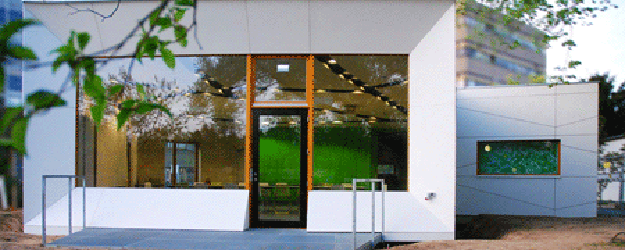30 January 2012
The Green School at the Botanic Garden of Johannes Gutenberg University Mainz (JGU) is not yet two years old but it has already established itself as a popular educational institution for young and old alike. Some 4,700 visitors came in 2011. UNESCO, the German federal state of Rhineland-Palatinate, and the Chamber of Architects have also honored this exceptional institution.
The mortars and pestles are ready, roasted cocoa beans are waiting to be processed into chocolate, and the logo of the famous TV game show "Who Wants to Be a Millionaire?" is being projected on the wall. On this particular morning, JGU’s Green School has been transformed into a chocolate workshop. A group of 24 high school students will very soon find out where chocolate actually comes from, how it is made, and how this sweet temptation is traded around the world.
"We normally offer this as a course for younger participants," explains Dr. Ute Becker. "However, the class said they especially wanted to do it, and so we modified it for them." As a research associate, Becker is the director of the Green School, which is located in the grounds of the Botanic Garden of Johannes Gutenberg University Mainz. The chocolate workshop is part of a series of courses developed for the Fair Tour scheme which she has been developed in partnership with the Mainz World Shop for Fair Trade.
Cocoa and the Fair Tour scheme
Class 10c of the Schlossgymnasium, a local high school in Mainz, arrives and the youngsters are immediately eager participants in the game show set up by the Green School team, even though they can only win cocoa beans instead of cash for correct answers. The first question is: "When were the first cocoa plants cultivated?" Possible answers: a) 4,000 years ago, b) 1,000 years ago, c) 500 years ago, or d) 100 years ago. Only a few get the right answer, i.e. 4,000 years ago. "That means that Jesus ate chocolate, too," interjects Lukas. His classmates smirk. "He could have, but only if he had actually lived where cocoa comes from," points out Gifty Amo-Antwi. She works for the Mainz World Shop for Fair Trade and organizes the chocolate workshop together with Dr. Ute Becker.
In June 2010, following a 12-month construction phase, the Green School opened as an extracurricular place of learning maintained by the JGU Faculty of Biology. The building, which houses basically one open-plan room, cost EUR 370,000. Architects Hans Harms and Michael Eckert designed it in the shape of a sprouting seedling. Lighting strips in the interior simulate a root system and the large windows provide a panoramic view of the Botanic Garden.
Experience the beauty of plants
Originally, construction was to be financed by private donations. Professor emeritus Elisabeth Gateff gave 50,000 EUR. "Children today see so much that is ugly, so it is important for them to experience the beauty of plants,"she said during the Green School opening ceremony. It was her generous contribution that inspired University President Professor Dr. Georg Krausch. In his view, if a private person was prepared to donate so much money, university and state should also be prepared to give generously. As a result, Krausch approached Minister Doris Ahnen of the Rhineland-Palatine Ministry of Education, Science, Continuing Education, and Cultural Affairs, and proposed that they together find the rest of the money needed, thus ensuring that the project was financed.
Class 10c has now finished the quiz and is en route to the Botanic Garden's greenhouses. Their task is to discover the cocoa plant, sugarcane, and the oil palm among the rain forest vegetation. The high school students have a lot of questions, for example: "How long does it take until cocoa beans can be harvested?" or "How do you get cocoa butter?" To get answers to these and their many other questions, they find information material concealed in the foliage. "Hey, look, a poison dart frog," marvels Serhat, standing in front of a terrarium. This may not exactly be on the program, but looking never hurt anyone.
Becker believes it is important for the Green School to offer courses and tours for every age group. In 2011 alone, 4,700 children and adults visited the school. "We have visitor growth rates of about 50 percent."
Accolades for the school
Although the institution is still young, it has already attracted a lot of attention. The Ministry of Education, Science, Continuing Education, and Cultural Affairs of Rhineland-Palatinate has designated the Green School a "School-like Environmental Education Facility of Rhineland-Palatinate" and the Fair Tour scheme has been adopted as an official project of UNESCO's Education for Sustainable Development program. Furthermore, the state's Chamber of Architects classified the building as an outstanding example of contemporary architecture.
However, all this is of little interest to the members of class10c. After viewing the greenhouses, they learn that cocoa farmers benefit little from the chocolate they grow because most of the profit is reaped by business and the distributors. Then it's everyone's turn to pitch in to produce chocolate. The roasted beans are difficult to husk, but become a fine powder once they are ground using mortar and pestle. Add only sugar and palm oil – and the paste is ready. Serhat is amazed: "It tastes better than the stuff you buy from the store."
Finally, the high schoolers evaluate the two-and-a-half hour chocolate workshop. "Interesting," "cool," and "very OK" are among the comments. "And they're being honest. Believe me, these guys really know how to complain if something doesn't suit them," says teacher Anna Monreal with a bright smile on her face. Next week, she'll be back with another class.


